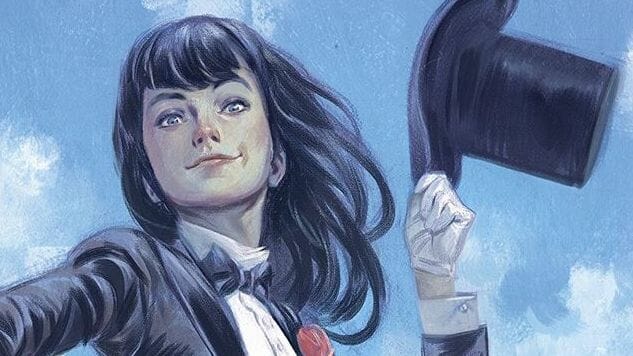Mystik U’s Alisa Kwitney Talks Campus Magic & Female Friendship
Main Art by Julian Totino Tedesco
It’s difficult for any new story about a magical school to avoid comparisons to Harry Potter, no matter the medium or focus, but DC Comics’ Mystik U did an admirable job breaking away from J.K. Rowling’s tropes. Rather than focusing on young children, the three-issue, self-contained Mystik U features an incoming class of freshman at the titular university, staffed by several familiar faces. The story follows a young Zatanna Zatara as she enrolls after accidentally unleashing her true powers during a stage-magic act, with serious negative consequences for her father. Writer (and former Vertigo editor) Alisa Kwitney and artist Mike Norton created the setting from scratch, and even if many of the faces on the page are familiar from other iterations, they’ve been updated and re-imagined, and the whole book is a refreshing and invigorating take on the long-underused magical side of the DC universe.
Dean Rose Psychic and her staff are struggling to identify an oncoming threat and nip it in the bud, but that conflict plays second fiddle to Zatanna’s social and academic issues. Even though many of the challenges she faces are specific to the magical nature of her education, Mystik U’s trials should feel familiar and relatable to readers who fumbled through their own transitions into adulthood. The series doesn’t shy away from tough subjects, and focuses on building strong relationships between female characters in a way that feels rewarding and all-too-rare. With the first arc collected in a trade out now in comic shops, Mystik U is an excellent great gateway comic for new readers who love shows like Shadowhunters (and of course Harry Potter), but it’s also perfect for veteran fans who miss Books of Magic and enthusiastically await the return of the Sandman universe this fall. To commemorate the trade collection, Paste exchanged emails with Kwitney to find out more about her “syllabus” for the series.
![]()

Mystik U Cover Art by Julian Totino Tedesco
Paste: Books like Mystik U provide a great chance to revisit characters that haven’t been seen in main continuity for a while, but it’s difficult to balance cameos and Easter eggs with the needs of new readers who might not familiar with them. How did you approach that challenge?
Alisa Kwitney: My main focus is always on writing a strong, character-based story, and in the case of Mystik U, I was approaching it as an ensemble piece, which meant making sure that each student had a clear arc. And I wanted Rose Psychic, the dean, to have an arc as well. So Easter eggs (or as I like to call them, Passover Afikomens) and cameos only get included when they don’t interfere with character development and conflict.
Actually, my favorite moments are the ones in which the cameos or Easter eggs actually complement the story arcs. That’s the Holy Grail of storytelling—when your fun moments are layered with something deeper than just the “a-ha” of recognizing an old character or callback.
Paste: Speaking of all those familiar faces, how did you choose which characters to include? The story may star Zatanna, but it features members of the Trenchcoat Brigade, Frankenstein, Xanadu and more.
Kwitney: With the exception of Enchantress, I tried to choose characters who have not appeared too recently in tons of books, so that there was some freedom to do a fresh take. And in the case of Enchantress, I was told that I could ignore the recent film version and go my own way. So I reread the older comic book bios and storylines, and then re-imagined each character.
When it came to Sebastian Faust, I was looking for a conflicted bad boy, because they are so much fun to write. Like Constantine, he has demon issues, but unlike Constantine, Faust’s past is relatively unexplored. There’s a lot to mine there. Also, he shared famous father issues with Zatanna.
Paste: Shifting a character that’s been portrayed as an adult to a younger version of themselves can be tough. With most of the core cast freshman in college, did you spend a lot of time thinking about their visual design? Did you and Mike Norton talk about outfits and how to leverage Zatanna’s classic costume for casual wear?
-

-

-

-

-

-

-

-

-

-

-

-

-

-

-

-

-

-

-

-

-

-

-

-

-

-

-

-

-

-

-

-

-

-

-

-

-

-

-

-











































